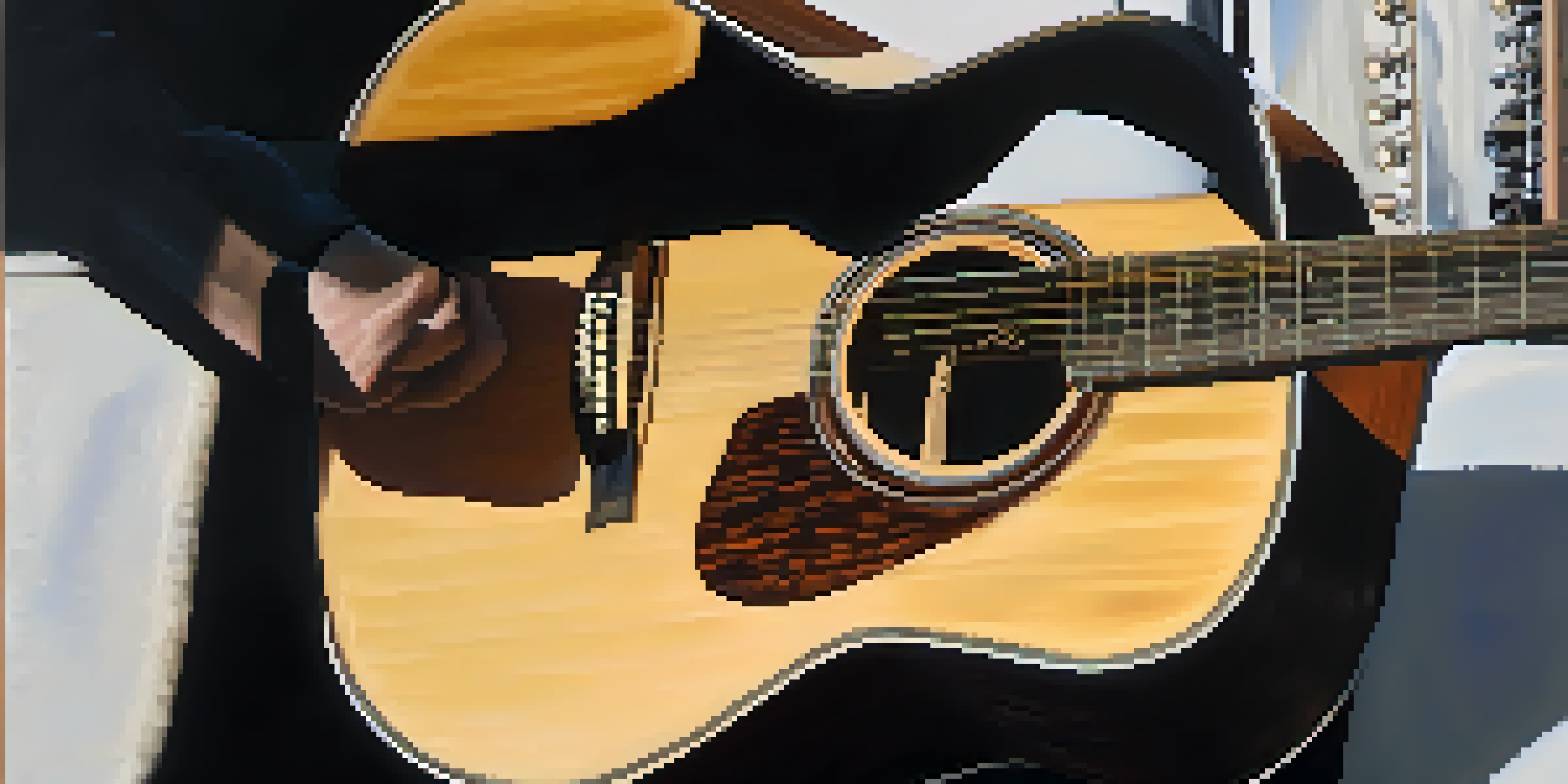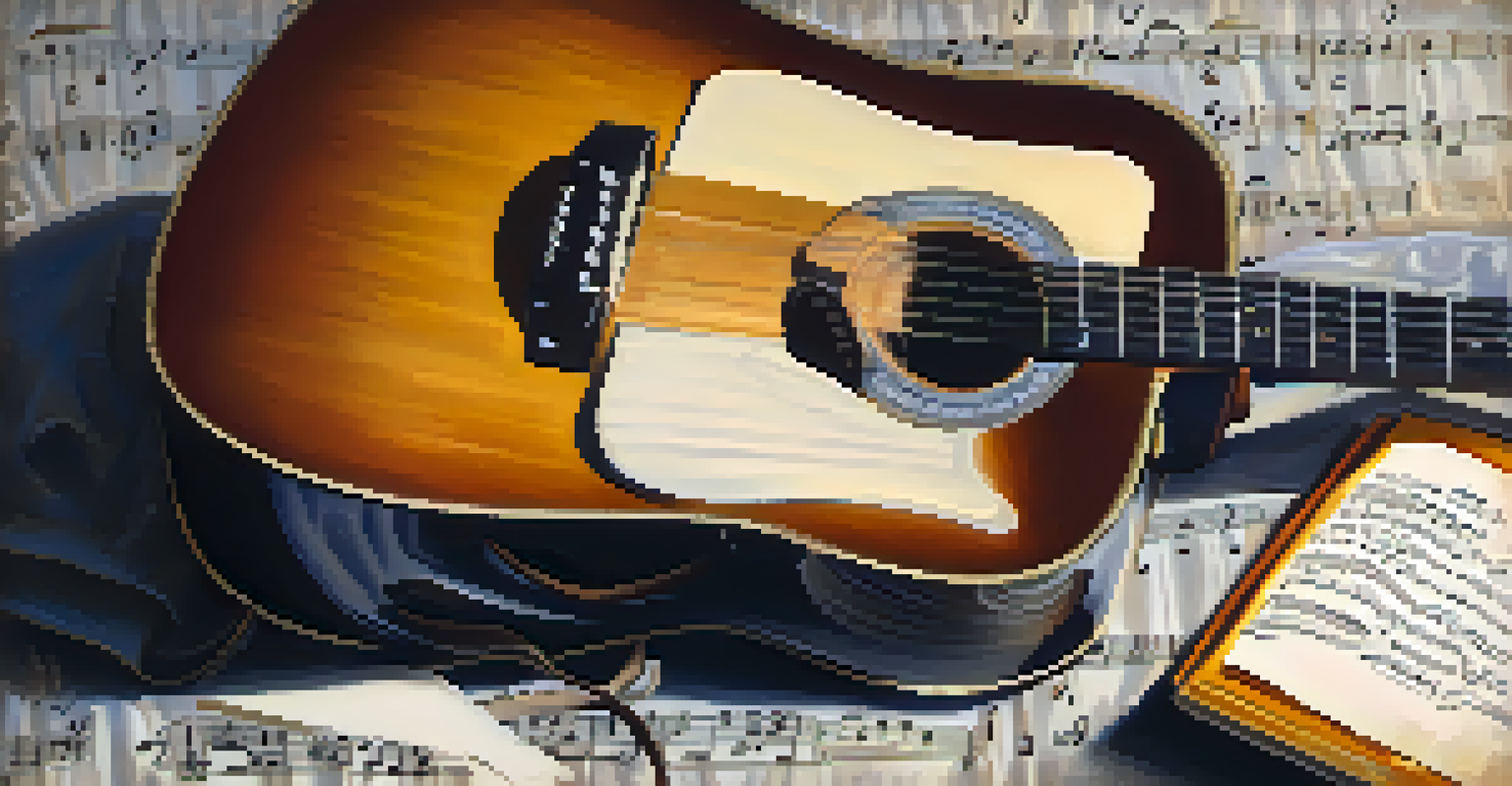Unlocking the Secrets of Open D Tuning for Acoustic Guitar

What is Open D Tuning and Why Use It?
Open D tuning is a popular alternate tuning for acoustic guitar, where the strings are tuned to the notes D-A-D-F#-A-D. This tuning creates a rich, resonant sound that can be particularly appealing for folk, blues, and slide guitar. Many musicians appreciate how it simplifies chord shapes, making it easier to play beautiful open chords.
Music is the shorthand of emotion.
One of the biggest advantages of Open D tuning is that it allows for more harmonics and overtones, giving your music a fuller sound. When you strum all six strings, you get a D major chord without any finger positioning, which can inspire creativity and new songwriting ideas. It's a fantastic way to break out of the standard E tuning rut.
Moreover, Open D tuning opens up a whole new world of fingerpicking patterns and slide guitar techniques. With just a little practice, you can unlock unique sounds that are difficult to achieve in standard tuning, turning your acoustic guitar into a versatile instrument.
Getting Started with Open D Tuning
To dive into Open D tuning, start by adjusting your guitar strings from standard E tuning. Use a tuner to ensure accuracy: the sixth string (lowest) should be a D, the fifth an A, the fourth a D, the third an F#, the second an A, and the first a D. This initial setup might feel strange, but it’s a necessary step toward exploring new musical horizons.

Once your guitar is in Open D tuning, it’s a good idea to familiarize yourself with basic chords. Start by playing the D major chord, then move on to other common shapes like G and A major, which are now easier to play. As you practice these chords, listen closely to the warmth and depth of the sound, which can be quite different from what you're used to.
Open D Tuning Simplifies Playing
Open D tuning allows musicians to easily play rich chords and explore new songwriting ideas without complicated finger positioning.
Experimentation is key! Don't hesitate to strum around and see what sounds good to you. You might stumble upon unexpected chord voicings or melodic ideas that spark your creativity, leading you to compose something entirely new.
Basic Chords in Open D Tuning
In Open D tuning, many common chords become more accessible. For instance, the D major chord is played by strumming all strings open, while the A major can be played by barring the second fret. This simplicity gives you the freedom to focus on your playing style and expressiveness.
The beautiful thing about learning is that no one can take it away from you.
Other chords like G major can be created by placing your fingers on the fifth fret of the lowest three strings. The beauty of Open D tuning lies not just in the ease of forming chords but also in the rich, full sound that resonates with each strum. This encourages players to experiment with different finger positions and voicings.
As you grow more comfortable, try incorporating seventh chords or diminished chords, which can add a unique flavor to your music. These variations will not only enhance your playing experience but also broaden your musical repertoire.
The Art of Fingerpicking in Open D Tuning
Fingerpicking in Open D tuning can be a game changer for your guitar playing. The open strings create a lush backdrop, allowing you to focus on intricate picking patterns. Start simple by alternating between bass notes and melody lines to get a feel for the tuning, then gradually introduce more complex patterns.
A great exercise is to practice arpeggios, which involve playing the notes of a chord one at a time. This technique not only develops your dexterity but also enhances your musicality. As you pick through the strings, listen for the harmonies created by the open notes interplaying with your fretted ones.
Enhances Fingerpicking Techniques
This tuning creates a lush sound that encourages intricate fingerpicking patterns and unique melodic ideas.
Don't forget to experiment with dynamics and tempo. Playing softly can create a delicate, intimate atmosphere, while a more vigorous approach can drive the music forward. Finding your personal style within this framework will make your fingerpicking feel more authentic.
Exploring Slide Guitar Techniques
Open D tuning is particularly well-suited for slide guitar, thanks to its resonant sound and open strings. When using a slide, you can glide effortlessly between notes, creating a smooth, vocal-like quality. Start by practicing simple melodies and scales, allowing the slide to do the work of connecting the notes.
To get the best sound, make sure your slide is positioned directly over the fret, not in between. This placement ensures a clear pitch and minimizes unwanted buzzing. As you gain confidence, try incorporating bends and vibrato to add expressiveness to your playing.
Many iconic blues and country songs feature slide guitar in Open D tuning, so listening to your favorite artists can provide inspiration. Try to emulate their techniques and then add your own twist. This blend of imitation and innovation will help you develop a unique slide style that resonates with your musical voice.
Famous Songs in Open D Tuning
Many well-known songs have made their mark using Open D tuning, showcasing its beauty and versatility. For instance, 'Brown Eyed Girl' by Van Morrison and 'Death Letter Blues' by Son House both feature this tuning, highlighting the rich, resonant sound it produces. These tracks can be a great learning tool for beginners.
Listening to these songs will not only familiarize you with the tuning but also inspire you to explore various playing techniques. Try to play along with the recordings, paying attention to how the artists use chords, fingerpicking, and slide techniques. This practice can enhance your understanding and application of Open D tuning.
Ideal for Slide Guitar Playing
Open D tuning's resonant sound is perfect for slide guitar, allowing smooth transitions between notes and expressive playing.
You might even find that these songs spark your creativity, encouraging you to write your own music in Open D. The essence of this tuning lends itself to a myriad of styles, allowing you to craft songs that express your unique voice.
Tips for Mastering Open D Tuning
Mastering Open D tuning takes practice, but there are some tips that can help speed up the process. Start with short practice sessions focusing on one aspect, whether it’s chord transitions or fingerpicking patterns. This focused approach can lead to quicker improvements and a more enjoyable experience.
Another helpful tip is to record yourself playing. Listening back can provide insights into areas where you can improve, as well as highlight your strengths. This practice can also document your progress over time, which can be quite motivating.

Lastly, don’t be afraid to experiment and make mistakes. Open D tuning is a playground for creativity, and the more you explore, the more you'll discover your unique sound. Embrace the journey and enjoy the music you create along the way!